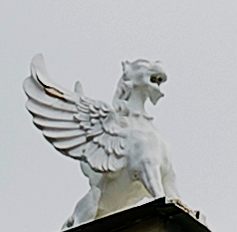





Gagarinsky Lane is located in the Central Administrative District of Moscow, spanning from Gogolevsky Boulevard to Plotnikov Lane. In the 1730s, it was the home of royal cup-bearer, Prince Bogdan Ivanovich Gagarin. Originally, the lane was called Staraya Konyushennaya Street: it was the main street of Konyushennaya Sloboda (neighborhood). By the end of the 17th century, it changed its name to Gagarinsky Lane.
In 1895, civil engineer Nikolay Faleev bought a wooden house located near the beginning of the lane. The house was built after the Great 1812 Fire. Mr. Faleev, who designed a number of public and private buildings on Prechistenskaya Embankment, in Varsonofievsky and Milyutinsky Lanes, rearranged the house to suit his own taste. He only kept the old wooden partitions, building new brick walls according to the new design. That was also when the main façade got the appearance it has today.
The new owner decorated his mansion with lavish ornaments. Small conches over main and side entrances are Baroque style. Griffin figurines adorn the corners; a strip of meander ornamental molding stretches over the windows. There’s a notable relief composition that gave the house its “masonic” name. It features an ax, pick, spatula, compass and rope crossed inside a triangle. In reality, however, that was nothing more than a statement of the owner’s trade: those tools were an official symbol of Russian civil engineers. The original cast iron fence is also still in place.
After October 1917, Faleev’s house was handed over to the People’s Commissariat for Internal Affairs. It was rented out to foreign diplomats and various famous foreigners as a guesthouse. Its official name was the People’s Commissariat for Internal Affairs House No. 10. One of its most notorious tenants was John Reed, one of the founders of the USA Communist Party, a Comintern figure and author of 10 Days That Shook the World, the book that detailed his own view of the October Revolution.
After the Great Patriotic War, the Moscow Executive Committee, guided by the Council of Ministers resolution, decided to hand nearly 50 mansions in Moscow to the Foreigner Service Bureau (now GlavUpDK under the MFA of Russia), to accommodate embassies and diplomatic missions. That was when the house in Gagarinsky Lane got its first long-term tenants, the Stevens couple: Edmund Stevens, an American journalist, and his Russian wife, Nina Andreevna.
Lots of high-ranked guests started frequenting the mansion: American politicians, Congressmen, businessmen, museum managers, notable collectors.
Here is what artist Vladimir Nemukhin, one of the regular visitors of the “house with griffins”, wrote: “There used to be many aesthetically sharp people among the foreigners who lived and worked in the USSR in that time. They were the first to express keen interest in the unofficial art and see it as not only a political statement, a sign of ideological conflict inside the Soviet society, but also as an organic new manifestation of the Russian art. Thanks to them, great collections of Russian underground art formed in the West. Nina Stevens and Norton Dodge owned the most expansive ones. Nina Andreevna Stevens occupied a very particular place among the Western underground art connoisseurs. In the early 1960s, Nina Stevens was literally hovering around “independent artists”. She was the one to organize the first “independent Soviet art” exhibition in the USA and advocated persistently for our art for years. ...
I am convinced that there is a lot “independent artists” owe to her, and not only as a person who was hard at work collecting and propagandizing their art. In the dim 1960s, her cozy house on Zatsepa Street, and later, her mansion on Ryleev Street, were a veritable magic lantern of the Western “dolce vita” for them”.
The house is now occupied by the Abkhazian Embassy.
The mansion in Gagarinsky Lane was repaired and refurbished time and again throughout its history. By the 2000s, water leaks all but destroyed its façade; the ornaments started crumbling in spots. In 2010-2011, GlavUpDK under the MFA of Russia funded a comprehensive restoration effort focused on returning the mansion to its historical appearance.
They strengthened the foundation and the interior brickwork, restoring the roof and ceilings. The surviving elements of molded decor, window platbands and roof railings were secured in place and the lost parts were reconstructed based on the original samples and archive documents.
Restoration architects working on the cultural heritage site the 19th Century City Manor Ensemble, noted that the restoration had been done to the highest quality standard. After the fencing repairs were completed and the surrounding grounds landscaped, that part of Gagarinsky Lane became complete, architecture-wise.